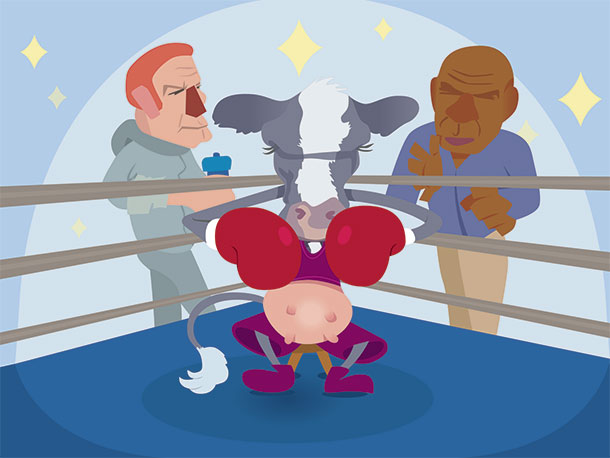
The second cow is also recently fresh and milking well; however, she is taking the milk off her back – she’s thin. She had some fresh cow metabolic issues. She will peak well, but it will take her a while to breed back and regain her bodyweight. It will be nip-and-tuck whether she gets pregnant and stays in the herd. Both cows will generate positive revenue. However, the first is truly a healthy cow, and the second cow would not qualify as healthy.

How about your organization, your dairy business? Is it organizationally healthy? One can look at the story of the two cows and relate this back to your dairy business. Is it bottom-line profitable? Is employee turnover essentially a nonexistent issue? Is productivity, both of cows and people, excellent? Is absenteeism a non-issue? Are there no politics, good morale and efficient use of resources?
Often, the business is “making it,” but at what cost? Owners often report they do not enjoy those they work with, not sure why people “just up and leave.” Why is it such a struggle? The second cow’s story illustrates why. She is producing because that is what she was designed to do, but she was not cared for or set up for success like she could have been.
This analogy is essentially the same for how we deal with our organizations. Organizations are living, breathing entities. Why? Because they are made up of humans. Humans, like cows, need to be well-cared-for, set up for success. They need to be in a good environment if they are to be productive and successful. The hard part of dealing with humans is: It can be messy and difficult. They talk back, they leave, they have feelings, and most of us were trained to do business, not deal with people.
To be a business that is healthy requires us as owners and managers to focus on a dual function: healthy bottom-line profitability and a healthy organization. They are not mutually exclusive, but rather synergistic. They key is: Neither can be ignored, or it will hurt both profitability and people.
What happens when we ignore the healthy workplace side of the equation? I hear comments like this: “They leave for 5 cents per hour.” “They don’t show up.” “They hide and don’t get work done.” “They don’t follow our protocols.” “I can’t afford to pay any more.” When I hear these comments, I immediately think this owner has no peace of mind. This owner is worried whether their workforce will show up, do a quality job, care for their cows, care for their equipment and facilities – just flat-out care. This state of being is emotionally draining. It makes staying passionate about what you do difficult at best.
What about bottom-line profitability? This is a concern for the obvious reason that it is what keeps a business in business.
I want to challenge you with this statement from Patrick Lencioni, author of The Advantage: “The single greatest advantage any company can achieve is organizational health. Yet it is ignored by most leaders, even though it is simple, free and available to anyone who wants it.”
All technology, marketing and finance is available to all businesses. There may be a size-of-scale advantage, but things like robots, health monitors, vaccines and feeds are available to all businesses. Having an excellent team puts one organization at a competitive advantage over another. Being able to attract top talent at every level and retain them is a competitive advantage. Having employees with institutional knowledge, commitment to excellence, little to no politics or gossip is a competitive advantage. Having a workforce with little to no turnover is a competitive advantage.
Why are the above items so elusive to businesses of all types? First, most business people think working on the health of their organizations is for someone else to do. It’s out of their comfort zone or not as important as the other functions of a business: finance, strategy, technology.
Organizational health is really simple and accessible. However, it takes courage, time, persistence and discipline. Second, many leaders are like first responders, always running to the latest crisis or the next idea that comes up. Never slowing down to deal with the urgent versus the emergency. Third, our current bookkeeping systems do not quantify the results of working on organizational health; they just track labor costs. The benefits of organizational health touch most aspects of a business’s profit and loss, and yet are not captured well on those reports, so it becomes easy to lose focus on this important aspect of a business.
What is a road map for this journey toward organizational health that encompasses both bottom-line profitability and a healthy workplace? It has four components, according to Lencioni: build a cohesive leadership team, create clarity, over-communicate clarity and reinforce clarity. I’ll briefly describe each of these core tenets of a healthy organization.
1. Build a cohesive leadership team
This is the number one item in your organizational foundation. Without it, there is slim likelihood of building a healthy organization. Not that an organization can’t be successful, but it decreases the odds of it reaching its full potential. Cohesive means there is a right-sized, manageable team; members of the team are united on where the business is going; they are able to be vulnerable with each other and those who report to them; they are willing to work on issues outside “their department;” they are accountable to each other and to results; they are willing to step into productive conflict to solve mission-critical issues.
2. Create clarity
The leadership team must create clarity around these six questions. If they do, then alignment among themselves and employees is possible. If there is not clarity among the leaders, then it is quite difficult for the whole team to be rowing in the same direction. The six critical questions are: Why do we exist? How do we behave? What do we do? How will we succeed? What is most important, right now? Who must do what?
When leaders and team members know the answers to the above questions, they know what to do; they know why they are doing it; they know how to treat each other, the cows, the equipment, the facility; they know how to track the score and if they are winning or not. Everyone wants to know if they are winning. No one likes it when everyone gets a trophy, even the losers.
3. Over-communicate clarity
Leaders need to communicate the six messages answered by the “clarity questions” over and over again. Their employees need to hear it multiple times for it to sink in. And they need to see that their leaders are actually living out their message in how they work and treat employees, cows, vendors, etc. It takes both verbally communicating the message repeatedly and living out the message as leaders.
4. Reinforce clarity
All systems and processes should communicate and reinforce the six messages. This makes the six messages a part of daily life. There should be a few critical, simple systems for staff to follow that have the six messages incorporated. Making it complicated means it won’t get implemented. Not making it part of daily chores means it doesn’t mean anything to the leaders. Hiring, promoting, training, reprimands should all have the six messages at their core. They will become intrinsic to your organization if you do. Everything should remind employees of the whys of your organization.
Remember, there are two kinds of cows you can milk. Both may produce profit, but one will be profitable for much longer than the other. ![]()
ILLUSTRATION: Illustrations by Corey Lewis.
Bruce Vande Steeg is a veterinarian by training and consults with dairies interested in improving their organizational health.

-
Bruce J. Vande Steeg
- MILC Group
- Email Bruce J. Vande Steeg






